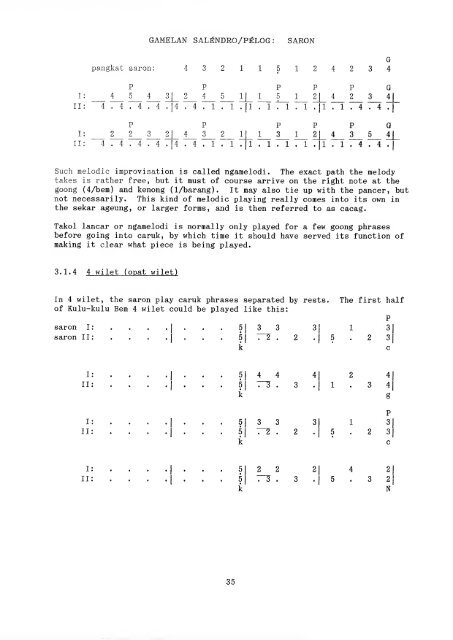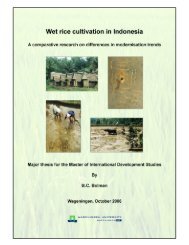Guide to Sundanese Music - Free EBooks Library
Guide to Sundanese Music - Free EBooks Library
Guide to Sundanese Music - Free EBooks Library
Create successful ePaper yourself
Turn your PDF publications into a flip-book with our unique Google optimized e-Paper software.
GAMELAN SALiNDRO/P:eLOG : SARON<br />
pangkat saron: 432115 124234<br />
P P P P G<br />
^ 111 5 1 2 14 2 3 41<br />
II: 4 . 4 . 4 . 4 . 14 . 4 . 1 . 1 . il . 1 . 1 . 1 . 11 . 1 . 4 . 4 .<br />
P P P P P G<br />
I: 2 2 3 2[ 4 3 2 1| 1 3 1 2| 4 3 5 4[<br />
II: 4 . 4 . 4 . 4 . 14 . 4 . 1 . 1 . II . 1 . 1 . 1 .11 . 1 . 4 . 4 .1<br />
Such melodic improvisation is called ngamelodi. The exact path the melodytakes<br />
is rather free, but it must of course arrive on the right note at the<br />
goong (4/bem) and kenong (1/barang). It may also tie up with the pancer, but<br />
not necessarily. This kind of melodic playing really comes in<strong>to</strong> its own in<br />
the sekar ageung, or larger forms, and is then referred <strong>to</strong> as cacag.<br />
Takol lancar or ngamelodi is normally only played for a few goong phrases<br />
before going in<strong>to</strong> caruk, by which time it should have served its function of<br />
making it clear what piece is being played.<br />
3.1.4 4 wilet (opat wilet)<br />
In 4 wilet, the saron play caruk phrases separated by rests. The first half<br />
of Kulu-kulu Bern 4 wilet could be played like this:<br />
saron I<br />
saron II:<br />
I:<br />
II:<br />
I:<br />
II;<br />
I;<br />
II;<br />
• •<br />
• • • I «<br />
35<br />
5| 3 3 3<br />
5)<br />
k<br />
7~^ . 2<br />
5| 4 4 4<br />
5| 7~^ . 3<br />
k<br />
5| 3 3 3<br />
5( 7T . 2 .<br />
ic<br />
P<br />
3|<br />
c<br />
5| 2 2 2| 4 2|<br />
5| rr . 3 . 5 . 3 2j<br />
I<br />
ic N<br />
4|<br />
41








